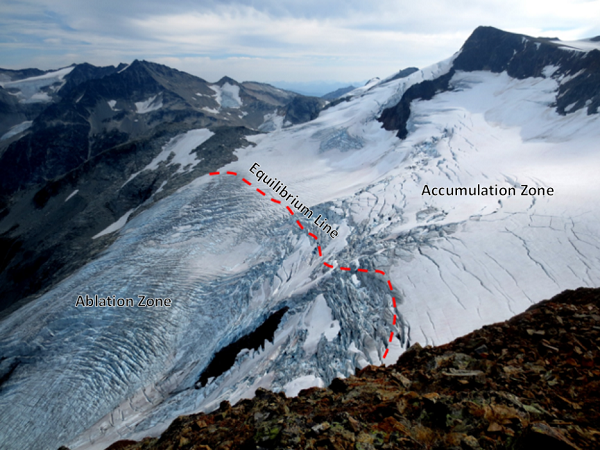A glacier is a very large, thick mass of ice that stays frozen from one year to the next and has the ability to move. If you squeeze a snowball really, really hard, it will eventually turn into an ice ball! Guess what - that's how a glacier is formed! Snow falls from the sky every winter, laying a white blanket over our landscape. High up in the mountains, this blanket of snow get very thick and in some places it doesn't completely melt away. Snow that lasts over the summer is called firn. When the next winter comes around, that firn gets buried by more snow, and more snow the year after that. The more the snow gets buried, the more it gets compressed and eventually turns into ice. Thousands of years of these cycles have formed thick glaciers in our mountains!
Glaciers are actually very, very slow moving solid rivers. The ice inside the glacier moves very slowly as gravity pulls the glacier down the mountain slope, which causes stretching and cracks to develop in the glacier ice. Also, water flows to the bottom of the glacier which makes it slide easier on the ground. Just like rivers, glaciers can erode the nearby land and transport a lot of material. Sometimes glaciers are referred to as "nature's bulldozers" because they can completely modify the landscape through these processes. To learn more about glacial erosion and deposition, watch this video.

A glacier in Alaska that can almost be mistaken as a river! Photo credit: Gabriel Wolken, DGGS.
Glaciers advance and retreat over time. To understand why, you need to know more about glaciers. A glacier consists of two major body parts, the ablation zone and the accumulation zone. The accumulation zone is the upper part of the glacier where snow and ice is gained. The ablation zone is the lower part of the glacier where snow and ice is lost because of melting in the summer. The equilibrium line (red dashed line on the picture below) is the line on the glacier that separates the accumulation zone from the ablation zone. If you stand on the equilibrium line in the summer, you might see lots of snow when you look uphill on the glacier. But if you look downhill, you will see glacier ice! During glacier retreat the equilibrium line moves higher up the glacier.

Over hundreds and thousands of years, glaciers move back and forth over parts of Earth's landscape. During years when more snow and ice are gained in the accumulation zone than what are lost in the ablation zone the glacier will move forward (advance). During years when more snow and ice are lost in the ablation zone than what are gained in the accumulation zone, the glacier will instead move backwards (retreat).
When scientists talk about climate change they often mention that the glaciers are shrinking. Most glaciers, ice caps, and ice sheets on our planet are retreating right now because the planet is getting warmer. The warmer it is, and the longer it is warmer, the more ice that melts. This also means that places that typically get a lot of snow are becoming a little less snowy and a little more rainy. Remember, glaciers need snow to grow in the winters - even to just stay where they are. So with less snow and more rain, along with warmer temperatures in the summer, glaciers will keep shrinking. Learn more about climate change in Alaska.
Glaciers are the #1 tourist attraction in Alaska! Alaska's alpine glaciers represent about 13% of all glaciers on Earth! In fact, currently there are about 100,000 glaciers in Alaska and only 650 even have names. All glaciers in Alaska originate high up in the mountains, but some are so big that they extend all the way down to the ocean (tidewater glacier) or spread out on valley floors (piedmont glaciers). Alaska's largest glacier, Bering Glacier, is also the largest and longest glacier in North America. It covers about 2,000 square miles which equals more than 950,000 football fields and is larger than the entire state of Delaware! (source)
A glaciologist studies glaciers! Glaciologists are interested in many different aspects of glaciers, from how and why glaciers change and the impacts of these changes on our planet, to what living things grow in or under a glacier. Traditionally, glaciologists have travelled up and down glaciers by walking or skiing to make measurements to determine the health of the glacier in order to calculate its mass balance (i.e., the health of the glacier by annual gain and loss of snow and ice). Nowadays, many of these measurements can be done with the use of satellite imagery.
Glacier changes can generate a range of hazards involving changes in water discharge (amount of water flowing in a system), outburst floods from ice-dammed lakes, slope instability, avalanches, erosion and sedimentation just to name a few. Research scientists at DGGS' Climate & Cryosphere Hazards Program monitor glacier change on multiple glaciers in Alaska, for example Valdez Glacier in the eastern Chugach Mountains and Bear Glacier on Kenai Peninsula.